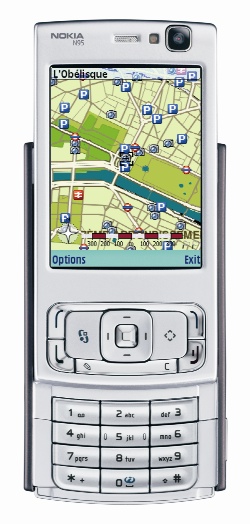In fact, it's often said that the likes of you (as an interested AAS reader) and I represent the geeks, the most technological 10% of phone buyers. I'd even go so far, based on worldwide numbers, as to say that we represent the top 1% and are statistically insignificant. Or would be if it weren't also for the fact that we 1% are also the ones who write all the articles, blog posts and reviews.
But that massive 99% remnant should be borne in mind when planning mobile devices and services, and ignored at a manufacturer's peril. Pandering to the Silicon Valley (or, in this case, West Sussex) crowd is only good up to a point.
 All this was brought home to me in a very interesting hour spent with a relative of mine. He's the archetypal 'normob who quite likes phones' and he's taken my advice several times in the past - his last two phones have been the Nokia N95 and E71, spanning the last 3 years. But his usage of both was, interestingly, somewhat different to what you or I might have done with the devices.
All this was brought home to me in a very interesting hour spent with a relative of mine. He's the archetypal 'normob who quite likes phones' and he's taken my advice several times in the past - his last two phones have been the Nokia N95 and E71, spanning the last 3 years. But his usage of both was, interestingly, somewhat different to what you or I might have done with the devices.
Ever since I renamed my video podcast from The Smartphones Show to The Phones Show, I've had in mind that, to the every day buyer, all these devices (even the highest end devices, technically) are just 'phones' at the end of the day. Anybody who types in 'smartphone' into Google probably already has a pretty good idea of what a smartphone is and of what they're actually after.
In short, I and others in the industry (helped by Apple's ubiquitous all-things-to-all-people iPhone) have wondered whether there will, one day, be a convergence of form factor, features and cost. Will phones be clever enough to present enough simplicity for 'normobs' and get have raw functionality beneath the surface to also satisfy the likes of you and I? Will there one day be a Grand Unified Theory of Phones?
Nope. Because that's based on a false premise: that all users are basically similar. They're not.
I'll point to my dear wife here, since she's so much of a normob that she'd be right at the opposite end of the scale to the likes of you and I. She could be using a £30 Samsung feature phone or a £500 iPhone or a £300 Nokia C7 and as long as she could read the screen and enter text messages using numeric multi-tap she'd be happy. But the gulf between what she wants from a phone and what I want is large enough to disprove the possibility of a Grand Unified Theory.
What was particularly interesting about my encounter with my relative was that he's bang in the middle of the phone spectrum: he's relatively computer literate, financially savvy and shops around for deals and upgrades and willing to take advice from others and from online reviews. And yet he's not really interested at all in what makes phones work, i.e. if he can get a phone to do what he wants without needing to know about files, folders, operating systems, SIS files, certificates, betas and firmwares, then he's very happy indeed. By all accounts, this is Mr Average to the phone shops, networks and manufacturers.
(Coming to the end of his 18 month contract on a Nokia E71 on '3', he was of course after some advice on what to buy next - maybe that'll make a good editorial for next time!)
 Music and radio both out
Music and radio both out
Given that I happened to be carrying around a fully tricked-out (hey, it's me!) Nokia E72, he was very interested to see what Nokia had improved for the 'new' model. I demoed the camera, the torch mode, the free sat-nav - and the 3.5mm audio jack. He was very into music and had copied a few tracks onto his memory card in the past but had been put off by the 2.5mm jack on the E71 as it couldn't take any of the headphones he normally had lying around.
But he was even more interested when I starting showing a few of the things I'd installed. I mentioned listening to Internet Radio on the E72. "Oh yes, this has radio too", he said, "but it's a pain having to find the headphones so that it can use them as an aerial". "No, no", I replied, "Internet Radio uses streaming radio from round the world, over the Internet". I demonstrated by asking for a country of his choice and showing hundreds of stations from that country alone.
Mind suitably blown, he wanted Nokia Internet Radio on his E71. After establishing that his '3' tariff did include 'unlimited data', we set to work - and hit a huge problem (for a normob) - it seems that this app isn't in the Ovi Store for the E71, possibly because the device is considered quite old now. A bit of geeky fiddling around in Web on the old Nokia Internet Radio web site produced the right SIS file, which I then installed, but this is a good example of where, if an application isn't listed in the 'on device' store then it might as well not exist.
Web unused and unloved
While in Web on his E71, I was somewhat aghast to see the contents of his 'Bookmarks', the sites that are listed when you open Web. They were the default '3'-centric links that had been provided with the E71. I'm guessing he'd rarely, if ever, browsed web sites on his phone, despite having a relatively capable device. This, of course, completely contradicts the Web-centric ethos for smartphones that comes out of, in particular, the USA at the moment. It seems that there is more to phones than browsing desktop web sites... who knew?
Baby steps in Social
My relative knew all about Twitter and Facebook, of course, and had accounts on both. But as far as I could tell from his app menus and Web history, there had been attempt to access either on the phone. Now the E71 predated the rise of these social networks - or at least that's Nokia's excuse for there not being obvious ways to get 'social' on this phone - but it's still interesting that there wasn't any frustration at not being able to interact with others on these services. I'm guessing many normobs wouldn't even think of being able to access Twitter and Facebook unless they happened to see a big blue 't' or F' icon and apps with the right name in the Ovi Store.
Asking about his use of Twitter, it transpired that he had about 3 followers and followed twenty-odd others. Quite possibly a far more representative 'normal' use of Twitter than the likes of you and I. If I don't check Twitter every hour, I start missing tweets completely - which is pretty sad, really [FX: hangs head in shame], whereas the normob can check every few days and hardy miss a thing. In an age when geeks moan about their client not being able to handle multiple Twitter accounts, it was rather refreshing to find a normal person whose life did not revolve around this microblogging service(!)
 Firmware irrelevant
Firmware irrelevant
Picture the scene at AAS Towers. New firmware is released for a Symbian-powered phone. The old version was 51.006, we now have 51.012. Klaxons go off, amber lights start flashing (we could switch them to red, but that would involve changing the bulbs*) and we run around like headless chickens looking under the sofa around the Internet for a changelog.
Meanwhile, back in normob land, my relative had never - repeat never updated his E71's firmware. In fact, he probably had never heard the term and wouldn't have known what to do if an upgrade was suggested. And - with the old E71 at any rate - he'd have had to manage backing up and restoring data afterwards. Which is possibly more than most people would contemplate without a friendly geek to hold their hand.
* joke courtesy of Red Dwarf and the BBC...!
Mapping a big hit
In contrast to the tale of geek-woe above, it seems that the word about Nokia Maps (now Ovi Maps, of course) has been getting out. He had used it on the N95 and now on the E71 quite regularly to find out where he was and, I believe, had even signed up for a couple of periods of voice navigation (the N95 being too old to qualify for free navigation and, given that he didn't know about firmware, ditto for the E71). He was impressed that my E72 came with navigation for free, out of the box and was clearly one of the driving factors in his next 'upgrade due' decision.
Thousands of Apps? Not so much
When the Interwebs resonate to the sound of press releases from the American OS vendors trumpeting that they've hit 100,000,or 200,000 (etc) applications in their App Store, and with me knowing full well that even the Nokia Ovi Store has 70,000 items currently, of which perhaps 10,000 (at least) are compatible with the older E71, have a guess how many apps my relative had installed? Guess again.
Two.
Both of which were trivial novelties and one of which generated bodily noises. To the geek, 'apps' mean Dropbox, Twitter, Evernote, and so on. Oh, and Angry Birds. In the popular/normob mind, 'apps' mean little trinkets, novelties of no particular use, rather sadly. I showed my relative - and installed for him - SPB TV and Snaptu, both freeware in the Ovi Store, and he was utterly blown away. For the rest of the day, he delighted in showing others how he was 'watching TV' on his phone.
BBC iPlayer a success though
I do my relative a slight disservice, actually, since there was a third 'app' that he'd installed and had been happily using. BBC iPlayer. More a widget-that-points-to-a-web-page than an app, he had found it in the Ovi Store and had got it going, watching streaming BBC shows from the last few weeks while on night shift duty. So kudos to both Nokia and the BBC for getting the word out about this uniquely UK-centric but invaluable service.
[In light of iPlayer and SPB TV and the newly installed Internet Radio, I then found myself hoping that '3's 'unlimited' data wasn't secretly limited or capped, else my relative would have been hit with a warning letter or, worse, a large bill!]

No GUT then?
Do you remember the Psion palmtops of the late 1990s? The Psion Series 5 and its EPOC operating system, effectively the great grand-daddy of the Symbian handsets of today, with in-app functionality (I refer you to Agenda as the shining example) that still hasn't really been equalled today, plus apps that we haven't even seen recreated yet, such as the wonderful flat-file Data. But, as EPOC became Symbian/ER6/Series 80, it started losing functions as the UI was subtly altered and simplified, then we had the switch to UIQ and to Series 60, both of which involved complete application rewrites and further simplification. The end result has been greater simplicity, the further we get down the line to today.
Yes, it's absolutely possible to provide a smartphone for everyman, something which is dumbed down enough to have few enough functions to be accessible to even technophobes. Phones like the Nokia 6630 (in its day, 2004), like the original Apple iPhone (in its day, 2007) hit this spot and sold in their tens of millions. What's the modern equivalent of these devices? I'm honestly not sure, though I bet Nokia would love me to quote the C7 here. Probably more like one of their Touch'n'Type handsets, running the new touch-ified Series 40? Comments welcome!
But we also need devices and application sets which can satisfy the likes of you and I, the N8s and iPhone 4s and Nexus S of this world. So I'll have to disappoint you by not presenting a Grand Unified Theory - though hopefully this editorial will nudge you into the same sort of reality check with your friends and family.
Steve Litchfield, AAS, 7 Dec 2010
